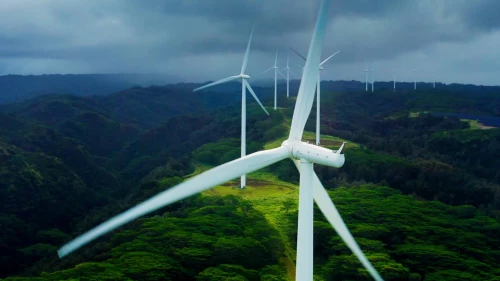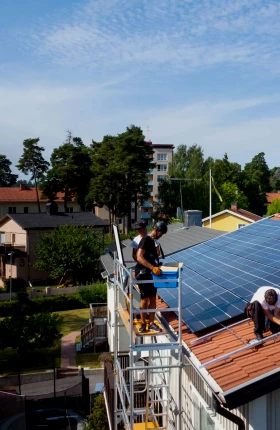For investors in North America, the challenges of climate change are creating correspondingly large opportunities for value creation. New technologies are emerging that, if funded, could contribute significantly to achieving climate and sustainability goals. At the same time, government policies are unlocking significant capital and changing the return profile. For investors, the biggest hurdle is making sense of these opportunities.

Vinay Shandal, Tariq Nanji, Mark Harris, Laura Borland, and William Lubega
Demand for climate investments is growing. Fundraising for climate funds nearly tripled in 2022, despite a 12% drop in private equity fundraising overall. That growth trend will accelerate. Between now and 2030, North America will require $6 trillion in additional capital if it is to stay on track to reach net zero by 2050. We estimate that private investors will commit up to eight times as much capital to the low-carbon economy by 2030 as they currently deploy. Government policies are a factor as well. The US has allocated $479 billion for climate and energy measures through the Inflation Reduction Act (IRA) and the Infrastructure Investment and Jobs Act. Similarly, Canada has allocated over $109 billion in federal incentives for climate transition technologies, in addition to adopting several province-level measures.
Despite their clear potential, these segments pose challenges to investors. Some companies are start-ups looking to fund first-of-a-kind commercial-scale facilities. Others are pursuing partnerships with corporates that need balance-sheet capital. Consequently, investors must weigh the risks related to new projects and technologies, higher capital intensity, and uncertain demand—often in the same opportunity. Traditional definitions of asset classes must expand in order for investors to pursue opportunities in this increasingly attractive space.
We analyzed eight climate subsectors that we believe can generate both climate impact and financial impact. (A similar BCG analysis looked at the
climate opportunity for private capital firms in Europe
.) Our findings are summarized in the following interactive exhibits, which let investors explore all eight subsectors in detail—including key opportunities along the entire value chain.
Interactive: Climate Opportunities
Our analysis of subsectors includes the following highlights:
- Carbon Capture, Utilization, and Storage (CCUS) and Direct Air Capture (DAC). CCUS and DAC technologies are critical to reducing emissions, but the sector is still in an early stage of development. In the case of CCUS, capacity must increase roughly 250-fold by 2050 to capture and offset emissions from hard-to-abate sectors such as cement and steel. Hubs are under construction around heavy-emitting sites to build the required transport and storage infrastructure. In the US, credit increases for both storage and utilization now make it possible to abate more than 300 megatons of CO2 emissions—more than eight times the current global capacity—at no additional cost. Similarly, the expansion of tax credits for sequestration (also known as 45Q tax credits) means that the CCUS project could soon have a net-negative cost for some emitters. Key opportunities in this area include carbon capture, storage, and transport infrastructure, and the underlying technologies used in these processes and supporting services.
- Low-Carbon Hydrogen. Demand for low-carbon hydrogen is projected to grow at double-digit rates through 2050, with the technology accounting for 6% of cumulative emissions reductions. Two primary forms of low-carbon hydrogen are ready to scale in North America: green hydrogen (produced by using renewable energy to power electrolyzers that split water into hydrogen and oxygen), and blue hydrogen (generated by reforming steam methane with carbon capture). Thus far, regional hydrogen hubs and clean hydrogen research initiatives have drawn approximately $9.5 billion in funding across North America, driven by policy incentives and maturing technology. Another $8 billion in production tax credits are available for projects that begin construction before 2033. Among the many opportunities for investors in low-carbon hydrogen are production infrastructure; the electrolyzers and fuel-cell technology used in the facilities, transportation, and storage infrastructure; and components for hydrogen infrastructure.
- Sustainable Fuels. Sustainable fuels are hydrocarbons made from organic waste (biofuels) or from hydrogen and CO2 (e-fuels) that can replace fossil fuels. Biofuels are the more mature category and are currently the only at-scale solution for decarbonizing transportation modes for which electrification is not viable, such as aviation, shipping, and trucking. Sustainable fuels enjoy strong policy support, including a $6 billion allocation in the IRA, coupled with incentives to support production economics from used cooking oil and animal-fat-based feedstocks. With regard to sustainable aviation fuel in particular, consumption must increase by a factor of 30 by 2030 to meet the targets that the Biden Administration and the International Air Transport Association have set. The high growth rate of this segment presents multiple opportunities for investors, including companies that aggregate and process scarce feedstock or offtake from refineries, equipment providers, and growth-stage companies that are developing and scaling biofuels. Investors can target opportunities in the processing plants needed to aggregate feedstocks in order to produce sustainable liquid fuels, as well as equipment providers and growth-stage companies that are developing and scaling biofuels.
- Renewable Natural Gas (RNG). RNG is made through anaerobic digestion of various organic feedstocks to produce biogas, which is then filtered to remove impurities, becoming pipeline-quality methane that can be directly injected into existing natural gas infrastructure. Demand is expected to grow 13% per year through 2040, with 70% of the incremental demand from gas utilities that have voluntary or mandatory RNG targets. An IRA investment tax credit will reduce RNG costs by 5% to 20%, depending on feedstock source and facility size. In addition, more than 20 US states have credit-based programs and cost-recovery mechanisms for utilities to produce and use RNG production. In the RNG value chain, investors can target facilities that process waste, equipment used in processing (digestors and other production technologies), and companies that trade credits for low-carbon fuel.
- Grid Renewables and Storage. Falling technology costs and policy incentives make renewables often the lowest-cost option for incremental energy capacity. Even unsubsidized, renewables now have a lower levelized cost of electricity vs. conventional energy sources like CCGT. In the US, the IRA and other incentives could shift the generation mix from 40% renewables in 2020 to up to 80% by 2030. In addition, approximately 35 states have established renewable power standards or goals to increase clean electricity penetration by 2050. Utility-scale storage, required to accommodate higher renewable penetration, is expected to rapidly grow to meet this demand. Significant transmission investment is needed to replace aging infrastructure and alleviate grid interconnection bottlenecks, creating opportunities for investors in infrastructure segments such as renewable generation, storage, and transmission, along with technology and supporting services. Opportunities in this subsector include renewable power generation, storage, and transmission; technology players such as battery-storage developers, or service providers (for example, companies developing programs to manage the performance of assets), among others.
- Distributed Energy Resources (DER) and Energy Efficiency. DER encompasses a range of power generation, storage, and efficiency solutions that can dynamically interact with the electricity grid across residential and commercial and industrial segments. New technologies such as fuel cells and electric vehicle (EV) charging have fueled rapid growth of the DER subsector, as have lower costs, favorable government policies, and an increased focus among companies and building owners on sustainability and resilience. Although implementation is still in its early stages, increased adoption will expand existing DER value pools and create new ones. Opportunities for investors in the DER subsector include C&I and community solar generation and storage, charging-station infrastructure and operators for EVs, companies that develop energy management systems for buildings, and various supporting services.
- Nature-Based Solutions and Markets. Demand for voluntary carbon offsets is expected to grow at 25% per year through 2030, driven by a need to meet near-term carbon-neutral goals and longer-term net zero targets from corporates and investors. More than 4,000 companies have made net zero commitments or set science-based targets, and many of them will require offsets to meet their goals, even as the supply of offsets is likely to remain constrained in coming years. The main opportunities for investors in this area are natural resources (such as projects to develop nature-based offsets through forestry, wetland, and agriculture), technology solutions (including science-based tools for verification), and advisory services such as project developers.
- Waste Management and Recycling. Greater emphasis on biodiversity, along with a need to reduce the environmental and geopolitical costs of extracting virgin materials, is transforming the waste management and recycling subsector. Opportunities for investors include building infrastructure to deal with different types of waste (such as municipal waste, biosolids, and hazardous waste), and recycling technologies and other businesses along the value chain.
Most of the climate-related opportunities discussed here present new technology, policy, and counterparty risks for investors to navigate. In that way, they may test the boundaries of asset classes and fund mandates. Yet investors that understand the range of opportunities across the eight subsectors we have identified—and their attendant risks—can accomplish the dual goal of slowing global warming while also generating a significant financial return.











